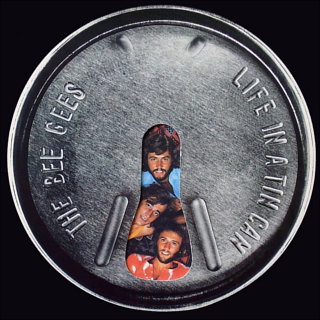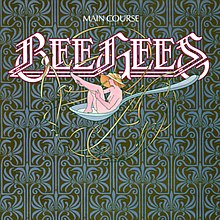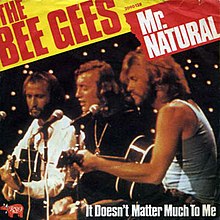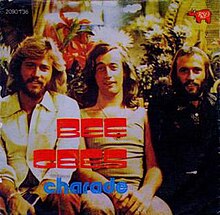
Rock and roll music
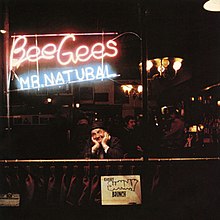
1974 studio album by the Bee Gees
Mr. Natural is the twelfth studio album (tenth internationally) by the Bee Gees, released in 1974. It was the first Bee Gees release produced by Arif Mardin, who was partially responsible for launching the group`s later major success with the follow-up album Main Course. The album`s rhythm and blues, soul, funk, and hard rock sounds initiated the group`s reinvention as a disco and blue-eyed soul act, which would solidify on subsequent albums. However, Barry Gibb has said that the album was "whiter" than Main Course.[2] The cover photograph was taken at 334 West 4th Street, Greenwich Village, New York City by Frank Moscati, which is today known as The Corner Bistro tavern.[3]
Leer másMr. Natural
The Bee Gees
Label: RSO · Studios: IBC (London); Command (London); Atlantic (New York) · Productor: Arif Mardin
CHARTS
AUS
US
|
1
|
Charade
The Bee Gees •
Bee Gees, The •
w: Barry and Robin Gibb •
v: Barry and Robin •
1974 /05
|
4:16 |
|
|
|
2
|
Throw A Penny
The Bee Gees •
Bee Gees, The •
w: Barry and Robin Gibb •
v: Barry and Robin •
1974 /05
|
4:52 |
|
|
|
3
|
Down The Road
The Bee Gees •
Bee Gees, The •
w: Barry and Robin Gibb •
v: Barry •
1974 /05
|
3:27 |
|
|
|
4
|
Voices
The Bee Gees •
Bee Gees, The •
w: Barry Gibb, Robin Gibb, Maurice Gibb •
v: Robin and Barry •
1974 /05
|
4:54 |
|
|
|
5
|
Give A Hand, Take A Hand
The Bee Gees •
Bee Gees, The •
w: Barry Gibb, Maurice Gibb •
v: Barry •
1974 /05
|
4:50 |
|
|
|
6
|
Dogs
The Bee Gees •
Bee Gees, The •
w: Barry and Robin Gibb •
v: Barry •
1974 /05
|
3:47 |
|
|
|
7
|
Mr. Natural
The Bee Gees •
Bee Gees, The •
w: Barry and Robin Gibb •
v: Robin and Barry •
1974 /05
|
3:51 |
|
|
|
8
|
Lost In Your Love
The Bee Gees •
Bee Gees, The •
w: Barry Gibb •
v: Barry •
1974 /05
|
4:40 |
|
|
|
9
|
I Can't Let You Go
The Bee Gees •
Bee Gees, The •
w: Barry Gibb, Robin Gibb, Maurice Gibb •
v: Barry •
1974 /05
|
3:49 |
|
|
|
10
|
Heavy Breathing
The Bee Gees •
Bee Gees, The •
w: Barry and Robin Gibb •
v: Barry and Robin •
1974 /05
|
3:30 |
|
|
|
11
|
Had A Lot Of Love Last Night
The Bee Gees •
Bee Gees, The •
w: Barry Gibb, Robin Gibb, Maurice Gibb •
v: Barry •
1974 /05
|
4:08 |
|
Singles
Mr. Natural
Fecha Lanzamiento: 29 March 1974 · Fecha Grabación: 1974 -Discográfica: RSO · · Productor: Arif Mardin
CHARTS
AUS
CAN
US
ALBUM
|
1
|
Mr. Natural
The Bee Gees •
Bee Gees, The •
w: Barry and Robin Gibb •
v: Robin and Barry •
1974 /03 /29
|
3:51 |
|
|
|
2
|
It Doesnt Matter Much to Me
The Bee Gees •
1974 /03 /29
|
0:00 |
|
Charade
Fecha Lanzamiento: August 1974 · Fecha Grabación: 1974 -Discográfica: RSO, Mercury · · Productor: Arif Mardin
CHARTS
ALBUM
|
1
|
Charade
The Bee Gees •
Bee Gees, The •
w: Barry and Robin Gibb •
v: Barry and Robin •
1974 /08
|
4:16 |
|
|
|
2
|
Heavy Breathing
The Bee Gees •
Bee Gees, The •
w: Barry and Robin Gibb •
v: Barry and Robin •
1974 /08
|
3:30 |
|
| Mr. Natural | ||||
|---|---|---|---|---|
 | ||||
| Studio album by the Bee Gees | ||||
| Released | May 1974[1] | |||
| Recorded | 14 November 1973 – 28 January 1974 | |||
| Studio | ||||
| Genre | ||||
| Length | 45:26 | |||
| Label | RSO | |||
| Producer | Arif Mardin | |||
| The Bee Gees chronology | ||||
| ||||
| Singles from Mr. Natural | ||||
| ||||
Review
1974 studio album by the Bee Gees
Mr. Natural is the twelfth studio album (tenth internationally) by the Bee Gees, released in 1974. It was the first Bee Gees release produced by Arif Mardin, who was partially responsible for launching the group`s later major success with the follow-up album Main Course. The album`s rhythm and blues, soul, funk, and hard rock sounds initiated the group`s reinvention as a disco and blue-eyed soul act, which would solidify on subsequent albums. However, Barry Gibb has said that the album was "whiter" than Main Course.[2] The cover photograph was taken at 334 West 4th Street, Greenwich Village, New York City by Frank Moscati, which is today known as The Corner Bistro tavern.[3]
Leer másThe LP was the Bee Gees` poorest charting album at the time, reaching No. 178 on the Billboard 200, but failing to chart elsewhere including in Europe where the group had previously enjoyed their most consistent popularity. However, it was a moderate success in the group`s adopted home of Australia where it reached No. 20.
Background
The decision to work with Mardin came after the RSO label rejected the brothers` post-Life in a Tin Can album, which had been provisionally entitled A Kick in the Head Is Worth Eight in the Pants.[4] Robert Stigwood was not ready to give up on the Bee Gees, but he did not believe in the musical direction they were taking. At the suggestion of Jerry Wexler and Ahmet Ertegun of Atlantic, Stigwood sent them to work with Atlantic producer and arranger Arif Mardin, who began to draw out their love of rhythm and blues music. Mardin brought the band`s attention to the dance scene unfolding at the time and the brothers Gibb in turn adapted their songwriting and arrangements to a more upbeat style.[5]
Recording
Recording began in November 1973 and although they were self-conscious about doing a really black sound, their first goal was to record songs in a way that they could reproduce on stage. They made more use of Alan Kendall`s lead guitar and added a keyboardist, which resulted in less recording for Maurice who had long overdubbed many instrumental and backing vocal parts; he would now focus almost exclusively on playing bass and singing backing vocals during the trio`s R&B/disco era. The new sound was more electric than much of what they had done since regrouping in 1970.
With Mardin at the helm, the Bee Gees returned to IBC Studios in London where they had recorded much of their pre-Life in a Tin Can output. The first two songs recorded were harder rock ("Heavy Breathing" and "I Can`t Let You Go"), both written in Los Angeles. This was a deliberate attempt to record a new sound compared to the acoustic sounds found on Life in a Tin Can. There were also two new backing musicians: Dennis Bryon on drums and Geoff Westley on keyboards who were in the tour band now made their debut with the Bee Gees on disc. Bryon was a friend of Kendall and would be the Bee Gees` drummer until 1980. The big change here was having Westley or in fact anyone play most of the piano and keyboard parts that had been Maurice`s domain for years.[6] Westley would soon be replaced as keyboardist by ex-Strawbs keyboardist Derek "Blue" Weaver whom Bryon had played with in Amen Corner.
Around this time, Maurice`s problems with alcohol began to surface; although he wrote few songs in 1974, he never missed a show or a recording session, but on this album, most of the new songs were written by Barry and Robin only.[7] Three songs were written by all three brothers; one, "Lost in Your Love" was a solo Barry composition while "Give A Hand, Take A Hand" was a Barry/Maurice composition (further information in the next paragraph). The songs "Mr. Natural" and "Had a Lot of Love Last Night" were recorded and completed at the Command Studios in London. The songs "Give a Hand, Take a Hand" and "Lost in Your Love" were recorded at Atlantic Studios in 1974.[6] Maurice said in an interview with Lynn Redgrave that his alcoholism didn`t affect his recording sessions and concerts until around the time of Spirits Having Flown.[8]
"When we did Mr. Natural, we didn`t have a positive direction", Maurice said, "We were thrashing about".[2] In an interview with the Bee Gees for Billboard on 24 March 2001, Maurice recalls about producer Arif Mardin, "Arif was brilliant, full of ideas. That`s why we did the Mr. Natural album with him, which was like a rehearsal".[9]
The gospel tinged song "Give a Hand, Take a Hand" was written in 1969 (hence Robin`s lack of writing credit since he wasn`t working with his brothers at the time) and originally recorded for their 1970 album Cucumber Castle, but was not released and was used by P.P. Arnold; her version was released in September 1969 as a single, which was produced by Barry Gibb.[10] The Staple Singers also covered "Give a Hand, Take a Hand"; their version was released on their 1971 album The Staple Swingers.
Reception
| Review scores | |
|---|---|
| Source | Rating |
| AllMusic | [11] |
| Rolling Stone | (not rated)[12] |
| The Rolling Stone Album Guide | [13] |
In a retrospective review, Bruce Eder of AllMusic said it was the "sultriest and most soulful record" from the group. He added that Mr. Natural was the "liveliest, most invigorating body of music to come from the group." He noted the "extraordinary sensuality" of the songs "Charade" and "Had a Lot of Love Last Night." At the end of his review, Eder concluded the album generated no hits, but it was their best album since Odessa.[11]
Track listing
All tracks written by Barry and Robin Gibb, except where noted.
| No. | Title | Writer(s) | Lead vocal(s) | Length |
|---|---|---|---|---|
| 1. | "Charade" | Barry and Robin | 4:13 | |
| 2. | "Throw a Penny" | Barry and Robin | 4:54 | |
| 3. | "Down the Road" | Barry | 3:35 | |
| 4. | "Voices" | Barry Gibb, Robin Gibb, Maurice Gibb | Robin and Barry | 4:50 |
| 5. | "Give a Hand, Take a Hand" | Barry Gibb, Maurice Gibb | Barry | 4:44 |
| No. | Title | Writer(s) | Lead vocal(s) | Length |
|---|---|---|---|---|
| 1. | "Dogs" | Barry | 3:43 | |
| 2. | "Mr. Natural" | Robin and Barry | 3:46 | |
| 3. | "Lost in Your Love" | Barry Gibb | Barry | 4:36 |
| 4. | "I Can`t Let You Go" | Barry Gibb, Robin Gibb, Maurice Gibb | Barry | 3:45 |
| 5. | "Heavy Breathing" | Barry and Robin | 3:26 | |
| 6. | "Had a Lot of Love Last Night" | Barry Gibb, Robin Gibb, Maurice Gibb | Barry | 4:07 |
Personnel
Credits from Bee Gees historian and sessionographer Joseph Brennan.[14]
Bee Gees
- Barry Gibb – lead, harmony and backing vocals; rhythm guitar
- Robin Gibb – lead, harmony and backing vocals
- Maurice Gibb – harmony and backing vocals, bass guitar (except “Had a Lot of Love Last Night”), Mellotron, Hammond organ
Additional musicians
- Alan Kendall – lead guitar
- Dennis Bryon – drums, percussion
- Geoff Westley – piano, keyboards
- Ben Law – fretless bass on "Had a Lot of Love Last Night"
- Phil Bodner – clarinet on "Charade"
- Arif Mardin – orchestral arrangement
Production
- Damon Lyon-Shaw – engineer
- Andy Knight, Alan Lucas, Gene Paul – engineer
- Arif Mardin – producer
Chart positions
| Chart (1974) | Peak position |
|---|---|
| Australian Albums Chart[15] | 20 |
| US Billboard 200[16] | 178 |
1974 studio album by the Bee Gees
Mr. Natural is the twelfth studio album (tenth internationally) by the Bee Gees, released in 1974. It was the first Bee Gees release produced by Arif Mardin, who was partially responsible for launching the group`s later major success with the follow-up album Main Course. The album`s rhythm and blues, soul, funk, and hard rock sounds initiated the group`s reinvention as a disco and blue-eyed soul act, which would solidify on subsequent albums. However, Barry Gibb has said that the album was "whiter" than Main Course.[2] The cover photograph was taken at 334 West 4th Street, Greenwich Village, New York City by Frank Moscati, which is today known as The Corner Bistro tavern.[3]
The LP was the Bee Gees` poorest charting album at the time, reaching No. 178 on the Billboard 200, but failing to chart elsewhere including in Europe where the group had previously enjoyed their most consistent popularity. However, it was a moderate success in the group`s adopted home of Australia where it reached No. 20.
Background
The decision to work with Mardin came after the RSO label rejected the brothers` post-Life in a Tin Can album, which had been provisionally entitled A Kick in the Head Is Worth Eight in the Pants.[4] Robert Stigwood was not ready to give up on the Bee Gees, but he did not believe in the musical direction they were taking. At the suggestion of Jerry Wexler and Ahmet Ertegun of Atlantic, Stigwood sent them to work with Atlantic producer and arranger Arif Mardin, who began to draw out their love of rhythm and blues music. Mardin brought the band`s attention to the dance scene unfolding at the time and the brothers Gibb in turn adapted their songwriting and arrangements to a more upbeat style.[5]
Recording
Recording began in November 1973 and although they were self-conscious about doing a really black sound, their first goal was to record songs in a way that they could reproduce on stage. They made more use of Alan Kendall`s lead guitar and added a keyboardist, which resulted in less recording for Maurice who had long overdubbed many instrumental and backing vocal parts; he would now focus almost exclusively on playing bass and singing backing vocals during the trio`s R&B/disco era. The new sound was more electric than much of what they had done since regrouping in 1970.
With Mardin at the helm, the Bee Gees returned to IBC Studios in London where they had recorded much of their pre-Life in a Tin Can output. The first two songs recorded were harder rock ("Heavy Breathing" and "I Can`t Let You Go"), both written in Los Angeles. This was a deliberate attempt to record a new sound compared to the acoustic sounds found on Life in a Tin Can. There were also two new backing musicians: Dennis Bryon on drums and Geoff Westley on keyboards who were in the tour band now made their debut with the Bee Gees on disc. Bryon was a friend of Kendall and would be the Bee Gees` drummer until 1980. The big change here was having Westley or in fact anyone play most of the piano and keyboard parts that had been Maurice`s domain for years.[6] Westley would soon be replaced as keyboardist by ex-Strawbs keyboardist Derek "Blue" Weaver whom Bryon had played with in Amen Corner.
Around this time, Maurice`s problems with alcohol began to surface; although he wrote few songs in 1974, he never missed a show or a recording session, but on this album, most of the new songs were written by Barry and Robin only.[7] Three songs were written by all three brothers; one, "Lost in Your Love" was a solo Barry composition while "Give A Hand, Take A Hand" was a Barry/Maurice composition (further information in the next paragraph). The songs "Mr. Natural" and "Had a Lot of Love Last Night" were recorded and completed at the Command Studios in London. The songs "Give a Hand, Take a Hand" and "Lost in Your Love" were recorded at Atlantic Studios in 1974.[6] Maurice said in an interview with Lynn Redgrave that his alcoholism didn`t affect his recording sessions and concerts until around the time of Spirits Having Flown.[8]
"When we did Mr. Natural, we didn`t have a positive direction", Maurice said, "We were thrashing about".[2] In an interview with the Bee Gees for Billboard on 24 March 2001, Maurice recalls about producer Arif Mardin, "Arif was brilliant, full of ideas. That`s why we did the Mr. Natural album with him, which was like a rehearsal".[9]
The gospel tinged song "Give a Hand, Take a Hand" was written in 1969 (hence Robin`s lack of writing credit since he wasn`t working with his brothers at the time) and originally recorded for their 1970 album Cucumber Castle, but was not released and was used by P.P. Arnold; her version was released in September 1969 as a single, which was produced by Barry Gibb.[10] The Staple Singers also covered "Give a Hand, Take a Hand"; their version was released on their 1971 album The Staple Swingers.
Reception
| Review scores | |
|---|---|
| Source | Rating |
| AllMusic | [11] |
| Rolling Stone | (not rated)[12] |
| The Rolling Stone Album Guide | [13] |
In a retrospective review, Bruce Eder of AllMusic said it was the "sultriest and most soulful record" from the group. He added that Mr. Natural was the "liveliest, most invigorating body of music to come from the group." He noted the "extraordinary sensuality" of the songs "Charade" and "Had a Lot of Love Last Night." At the end of his review, Eder concluded the album generated no hits, but it was their best album since Odessa.[11]
Track listing
All tracks written by Barry and Robin Gibb, except where noted.
| No. | Title | Writer(s) | Lead vocal(s) | Length |
|---|---|---|---|---|
| 1. | "Charade" | Barry and Robin | 4:13 | |
| 2. | "Throw a Penny" | Barry and Robin | 4:54 | |
| 3. | "Down the Road" | Barry | 3:35 | |
| 4. | "Voices" | Barry Gibb, Robin Gibb, Maurice Gibb | Robin and Barry | 4:50 |
| 5. | "Give a Hand, Take a Hand" | Barry Gibb, Maurice Gibb | Barry | 4:44 |
| No. | Title | Writer(s) | Lead vocal(s) | Length |
|---|---|---|---|---|
| 1. | "Dogs" | Barry | 3:43 | |
| 2. | "Mr. Natural" | Robin and Barry | 3:46 | |
| 3. | "Lost in Your Love" | Barry Gibb | Barry | 4:36 |
| 4. | "I Can`t Let You Go" | Barry Gibb, Robin Gibb, Maurice Gibb | Barry | 3:45 |
| 5. | "Heavy Breathing" | Barry and Robin | 3:26 | |
| 6. | "Had a Lot of Love Last Night" | Barry Gibb, Robin Gibb, Maurice Gibb | Barry | 4:07 |
Personnel
Credits from Bee Gees historian and sessionographer Joseph Brennan.[14]
Bee Gees
- Barry Gibb – lead, harmony and backing vocals; rhythm guitar
- Robin Gibb – lead, harmony and backing vocals
- Maurice Gibb – harmony and backing vocals, bass guitar (except “Had a Lot of Love Last Night”), Mellotron, Hammond organ
Additional musicians
- Alan Kendall – lead guitar
- Dennis Bryon – drums, percussion
- Geoff Westley – piano, keyboards
- Ben Law – fretless bass on "Had a Lot of Love Last Night"
- Phil Bodner – clarinet on "Charade"
- Arif Mardin – orchestral arrangement
Production
- Damon Lyon-Shaw – engineer
- Andy Knight, Alan Lucas, Gene Paul – engineer
- Arif Mardin – producer
Chart positions
| Chart (1974) | Peak position |
|---|---|
| Australian Albums Chart[15] | 20 |
| US Billboard 200[16] | 178 |
More Albums same artist
VIDEOS
See Video Album Mr. NaturalCharade · Channel: Bee Gees - Topic · 4m 14s


Throw A Penny · Channel: Bee Gees - Topic · 4m 50s

Down The Road · Channel: Bee Gees - Topic · 3m 26s

The Bee Gees - Voices · Channel: SoulMan · 4m 56s

The Bee Gees - Give A Hand, Take A Hand · Channel: SoulMan · 4m 53s

Dogs · Channel: Bee Gees - Topic · 3m 44s

Mr. Natural · Channel: Bee Gees - Topic · 3m 49s

Lost In Your Love · Channel: Bee Gees - Topic · 4m 38s

I Can't Let You Go · Channel: Bee Gees - Topic · 3m 46s

Heavy Breathing · Channel: Bee Gees - Topic · 3m 27s




